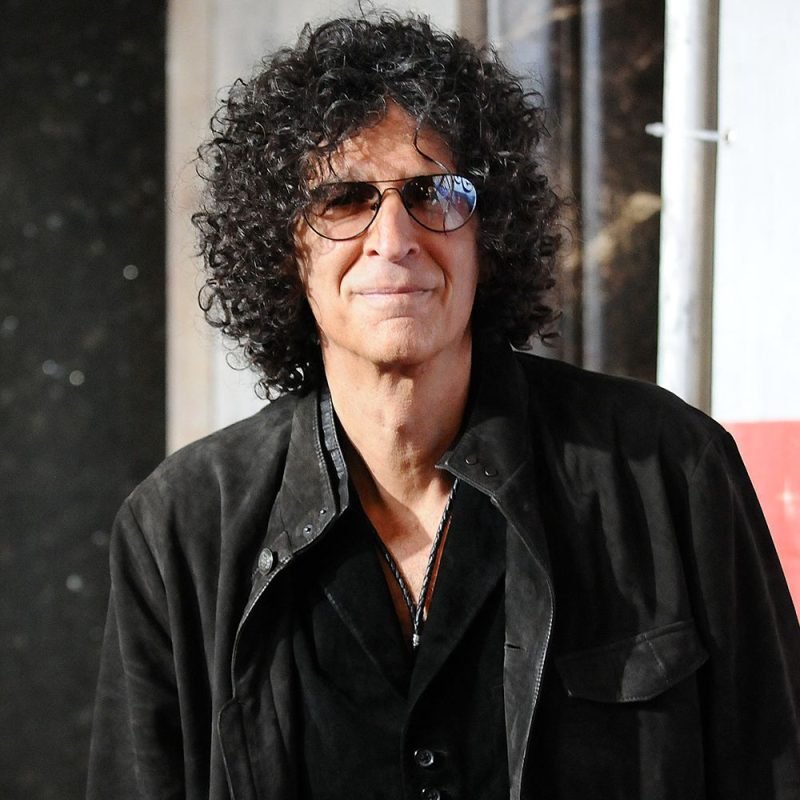About Howard Stern
Howard Allan Stern, born on January 12, 1954, is a renowned American broadcaster and media personality. He introduced his distinctive “shock jock” radio style to New York audiences in 1982, taking his show to national syndication by 1986. Despite challenges from the FCC, Stern, known as the “King of All Media,” transitioned to satellite radio in 2004. Additionally, he is an accomplished author, with multiple best-selling books to his name, and has showcased his talents as a judge on the popular TV competition show America’s Got Talent.
Stern has achieved outstanding recognition in the industry, amassing a multitude of prestigious awards. Among his impressive accolades, he has been crowned Billboard’s Nationally Syndicated Air Personality of the Year a remarkable eight times in a row. Moreover, he stands as the inaugural figure to host the top-rated morning show in both New York City and Los Angeles at the same time. Since 1992, Stern has confidently proclaimed himself as the unrivaled “King of All Media,” a testament to his unparalleled triumphs beyond the realms of radio.
Howard Stern Biography: Quick Facts
- Name: Howard Allan Stern
- Birth date: January 12, 1954
- Birth Place: New York city, United States
- Gender: Male
- Career: Broadcaster, Media Personality
- Best Known For: His most renowned achievement is hosting The Howard Stern Show, which rose to fame during its national syndication on terrestrial radio from 1986 to 2005. Since 2006, he has continued to captivate audiences on Sirius XM Radio.
Early Life
Howard Allan Stern, the second child of Ben (1923–2022) and Ray (née Schiffman) Stern (b. 1927), was born on January 12, 1954, in the Jackson Heights neighborhood of Queens in New York City. Stern’s parents are from Jewish descent, with origins in Poland and Austria-Hungary.
Ray worked as an office clerk before becoming a homemaker and later transitioning to work as an inhalation therapist. Ben served in the U.S. Army during the war and later pursued a career as a radio engineer and as a co-owner and operator at a Manhattan recording studio. Stern’s older sister, Ellen, was described by him as the “complete opposite” of himself and “very quiet.” The self-proclaimed “King of All Media” spent his early years in the mile-square village of Roosevelt, Long Island.
Stern’s early interest in radio and recording appears to have been acquired from his father, who was a part-owner of a recording studio and regularly filmed his son and daughter on holidays. The occasionally irritable father regularly challenged his children on current events, an open invitation for his little son to be caustic when he didn’t know the answers.
Stern attended Washington-Rose Elementary School followed by Roosevelt Junior-Senior High School. Stern also attended Hebrew school and was given the name Tzvi. In June 1969, the family relocated to Rockville Centre, and Stern, who was just fifteen at the time, switched to South Side High School. This new environment transformed him into a complete introvert. Eventually, he successfully graduated from the school in 1972.
That same year, Stern made the conscious decision to turn down a spot at Elmira College. Instead, he chose to pursue a communications degree at Boston University. However, due to his average high school grades, he had to begin his studies in the College of Basic Studies for the first couple of years. During his second year, he began working at the campus radio station WTBU, where he played music, delivered the latest news, and hosted interview programs. Alongside three classmates, he eventually co-hosted a weekly comedy show called The King Schmaltz Bagel Hour, despite the initial cancellation due to a controversial racial sketch titled “Godzilla Goes to Harlem”.
In 1974, he was admitted to the university’s School of Public Communication. In July 1975, he enrolled in the Radio Engineering Institute of Electronics in Fredericksburg, Virginia, where he earned a first-class radio-telephone operator license, a Federal Communications Commission-issued certificate required of all radio broadcasters at the time.
Stern’s first professional radio employment was at WNTN in Newton, Massachusetts, where he worked air shifts, newscasting, and production from August to December 1975. He spent the following five months teaching pupils fundamental electronics in preparation for their own FCC examinations. Stern later graduated magna cum laude in May 1976, with a 3.8 grade point average. His major was radio and cinema; his minor was English and Speech.
Early Career
After graduating from BU, Stern wasted no time in pursuing his radio career. His initial opportunity came at a small radio station in Briarcliff Manor, New York. It was during this experience that he realized he would only face a life of mediocrity if he stuck to being a regular deejay. Determined to break the mold, Stern decided to experiment. He dared to combine phone conversations with music, a combination that was deemed outrageous and blasphemous at the time.
However, Stern knew deep down that this was exactly what he wanted to pursue. With his innovative approach, Stern ventured on to Hartford, Connecticut, and later to Detroit. When the station in Michigan changed its format to country and western music, Stern promptly made his escape to Washington, D.C.
During his time in D.C., Stern made remarkable progress in his career and crossed paths with Robin Quivers, a newswoman and former U.S. Air Force nurse, who joined his radio team. Stern also started to gain recognition for his unconventional behavior. In January 1982, after an Air Florida flight crashed into the 14th Street Bridge in D.C., Stern made a bold move by calling the airline and asking, “What’s the price of a one-way ticket from National Airport to the 14th Street Bridge? Is that going to be a regular stop?”
After returning to New York later in the year, Stern was faced with unforeseen obstacles before he could even begin his new job at WNBC-AM. His apprehensive superiors presented him with a lengthy list of restrictions, including a ban on “jokes or sketches related to personal tragedies,” and “slander, defamation, or personal attacks on private individuals or organizations without consent or part of the act.”
Initially, Stern, after having been neutered, made an effort to be agreeable and comply with the station’s regulations. However, it didn’t take long for the deejay to unleash his full force against the station. He boldly introduced segments such as “Sexual Innuendo Wednesday” and “Mystery Whiz,” which engaged listeners in guessing who was using the restroom. Ultimately, in 1985, Stern was dismissed, granting him the freedom to eventually join forces with the esteemed New York City-based station, WXRK, famously known as K-ROCK.
The Howard Stern show
Stern’s radio career skyrocketed at the new station as he confronted two of his favourite topics—race and sex—in provocative ways. To the amazement of radio executives but not devoted fans, Stern, who sits in the station’s morning slot, dethroned WNBC’s Don Imus to take the ratings crown. A year after his debut, Stern took the extraordinary step of syndicating his program, which enabled him to expand into other major cities such as Philadelphia, Washington, D.C., and, ultimately, Los Angeles, New Orleans, Las Vegas, San Francisco, Dallas, Boston, and Chicago.
Stern was a ratings success, thanks to a recognizable and skilled on-air crew that featured Quivers, producer Gary “Baba Booey” Dell’Abate, writer Fred Norris, and stand-up comic/writer Jackie “the Jokeman” Martling. By 1993, he was in 14 cities and had around 3 million daily listeners.
Much of it was attributed to the show’s bold outlook. In one noteworthy occasion in 1992, Stern sent journalist “Stuttering” John Melendez to a Gennifer Flowers news conference, where she prepared to field questions from reporters about her alleged romance with then-Presidential candidate Bill Clinton. To the dismay of his “colleagues” at the dinner, Melendez didn’t mince words, asking Flowers if Clinton practiced safe sex and if she planned to sleep with any other candidates.
‘Private Parts,’ ‘Miss America’ and Clear Channels Termination of Stern’s contract
Stern’s popularity skyrocketed shortly after the release of his autobiography, Private Parts, a detailed, humorous look at Stern’s life that also paid tribute to his wife, Alison, and the work she’d done raising their three daughters, Emily Beth (b. 1983), Deborah Jennifer (b. 1986), and Ashley Jade (b. 1993).
Private Parts sold over 500,000 copies in its first month, making it Simon & Schuster’s fastest-selling book in its 70-year history. After reaching the top of The New York Times best-seller list in October 1993, it remained there for a whole month.
In 1995, Stern released another best-seller, Miss America. Private Parts became a popular film in 1997, featuring Stern himself. Stern’s rising fame and pay (by 1995, he was rumoured to be making $8 million per year from just the radio show) scarcely limited him. Instead, it appeared to unleash more of the same qualities that had made him successful.
Following the murder of Tejano singer Selena, Stern humiliated her by playing gunfire over her songs. Stern also stated that “Spanish people have the worst taste in music,” which sparked demonstrations and a warrant for his arrest issued by a justice of the peace in Harlingen, Texas. Stern later apologized for his statements.
Another tempest occurred in April 1999, when Stern questioned why the Columbine High School shooters did not try to have sex with some of the girls before killing them. The Colorado State Legislature censured the shock jock. Of course, Stern’s behaviour drew the attention of more than just radio listeners. He also proven unpopular with the Federal Communications Commission. In 2005, the FCC fined Stern’s employers around $2.5 million.
Clear Channel, the country’s largest radio station chain at the time, terminated Stern after an especially contentious show in which a call-in listener used a racial slur and Rick Solomon, Paris Hilton’s ex-boyfriend and the man involved in her infamous sex video, described in detail his relationship with the famous socialite.
The consequent fines, as well as subsequent battles with the FCC over control of his show, laid the groundwork for Stern’s permanent departure from terrestrial radio. In 2005, he secured a $500-million contract with Sirius Satellite Radio. On January 9, 2006, he began broadcasting entirely via the subscription-based radio service.
Stern moves to satellite radio:
Once liberated from the restrictions of FCC regulations, Stern’s show fearlessly pushed the boundaries of radio, bringing him immense wealth. In addition to his lucrative contract, Stern played a pivotal role in propelling the popularity of satellite radio. By 2005, Sirius had gained 2.2 million new subscribers, marking a staggering 190 percent surge from the previous year. Surpassing all expectations, these remarkable figures resulted in Stern amassing a staggering $200 million in Sirius stock.
After expressing his disdain for his last decade under the FCC, Stern found renewed vigor after transitioning to satellite radio, signing on for another five years in 2010. However, challenges arose when he entered a legal dispute with Sirius over stock rewards in 2010, claiming the company owed his production company and agent $330 million. Despite his efforts, the suit was dismissed in 2012, and the subsequent appeal ruled against Stern.
America’s Got Talent (2011), Hall of Fame Inductions and ‘Howard Stern Comes Again’
Stern took over as a judge on the show America’s Got Talent in 2011, replacing Piers Morgan. Alongside returning judges Sharon Osbourne and Howie Mandel, Stern, known for his tough criticism, showed unexpected support to contestants at times, displaying his sharp sense of humor. He stayed on for four seasons before leaving the show in 2015, making way for executive producer Simon Cowell.
In 2012, Stern was inducted into the National Radio Hall of Fame. Despite this honor, he has remained openly critical of the organization. Notably, in 2013 and 2014, Stern and Simon Cowell shared first place on Forbes’ list of America’s highest-paid television personalities, each earning $95 million. Furthermore, in 2015, Stern was recognized by Forbes as the world’s highest paid media personality and the fifth highest earning celebrity worldwide, solidifying his status as a dominant figure in the industry.
Stern inducted Bon Jovi into the Rock and Roll Hall of Fame in April 2018. On March 2019, Stern revealed the upcoming release of his third book, “Howard Stern Comes Again,” to be published by Simon and Schuster. The book hit the shelves on May 14, 2019. In December 2020, Stern extended his contract with SiriusXM, guaranteeing five more years of his show. In June 2022, Stern expressed his aspirations of running for President of the United States in 2024, contingent upon Donald Trump becoming the Republican nominee once again.
Personal Life
Stern initially met Alison Berns, his first wife, while studying at Boston University through a mutual connection. Their relationship blossomed, and they wed at Temple Ohabei Shalom in Brookline, Massachusetts, on June 4, 1978. Together, they welcomed three daughters: Emily Beth (b. 1983), Debra Jennifer (b. 1986), and Ashley Jade (b. 1993).
However, in October 1999, they made the difficult decision to separate. Stern then relocated from their shared home in Old Westbury, New York, to a sprawling 4,000-square-foot apartment in Millennium Tower on the Upper West Side of Manhattan, which he had purchased for $4.9 million in 1998.
During the months he was single, Stern dated Angie Everhart and Robin Givens. He sought the help of a psychotherapist. Then, in 2000, he embarked on a relationship with model and television host Beth Ostrosky. Their engagement was announced on his radio show on February 14, 2007, and they exchanged vows at the Le Cirque restaurant in New York City on October 3, 2008.






